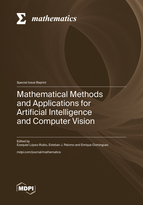Mathematical Methods and Applications for Artificial Intelligence and Computer Vision
A special issue of Mathematics (ISSN 2227-7390). This special issue belongs to the section "Mathematics and Computer Science".
Deadline for manuscript submissions: closed (15 February 2023) | Viewed by 50652
Special Issue Editors
2. Biomedic Research Institute of Málaga (IBIMA), 29010 Málaga, Spain
Interests: neural networks; deep learning; computer vision; pattern recognition; unsupervised learning
2. Biomedic Research Institute of Málaga (IBIMA), 29010 Málaga, Spain
Interests: artificial intelligence; artificial neural networks; deep learning; unsupervised learning; computer vision; image processing
2. Biomedic Research Institute of Málaga (IBIMA), 29010 Málaga, Spain
Interests: neural networks; deep learning; computer vision; pattern recognition; optimization problems; discrete mathematics; location problems; logistics
Special Issues, Collections and Topics in MDPI journals
Special Issue Information
Dear Colleagues,
Recent advances in machine learning and pattern recognition have sparked a revolution in many fields of artificial intelligence. Automated extraction of knowledge from Big Data has led to myriad accomplishments in science and technology. In particular, computer vision has dramatically benefited from deep learning and other advanced methods. Mathematical models are a key factor to the success of these strategies since they enable a quantitative understanding of the underlying learning processes, as well as provide a principled, solid foundation for the evaluation of such approaches.
This Special Issue will focus on recent theoretical and applied studies of computational intelligence and related fields, emphasizing computer vision. Topics include but are not limited to:
- Supervised learning;
- Unsupervised learning;
- Reinforcement learning;
- Deep learning;
- Pattern recognition;
- Image analysis and enhancement;
- Computer vision;
- Natural language processing;
- Time-series analysis;
- Data mining.
Advances in mathematical methods for artificial intelligence and computer vision and their cutting-edge applications are particularly welcome in this Special Issue.
Prof. Dr. Ezequiel López-Rubio
Dr. Esteban J. Palomo
Prof. Dr. Enrique Domínguez
Guest Editors
Manuscript Submission Information
Manuscripts should be submitted online at www.mdpi.com by registering and logging in to this website. Once you are registered, click here to go to the submission form. Manuscripts can be submitted until the deadline. All submissions that pass pre-check are peer-reviewed. Accepted papers will be published continuously in the journal (as soon as accepted) and will be listed together on the special issue website. Research articles, review articles as well as short communications are invited. For planned papers, a title and short abstract (about 100 words) can be sent to the Editorial Office for announcement on this website.
Submitted manuscripts should not have been published previously, nor be under consideration for publication elsewhere (except conference proceedings papers). All manuscripts are thoroughly refereed through a single-blind peer-review process. A guide for authors and other relevant information for submission of manuscripts is available on the Instructions for Authors page. Mathematics is an international peer-reviewed open access semimonthly journal published by MDPI.
Please visit the Instructions for Authors page before submitting a manuscript. The Article Processing Charge (APC) for publication in this open access journal is 2600 CHF (Swiss Francs). Submitted papers should be well formatted and use good English. Authors may use MDPI's English editing service prior to publication or during author revisions.
Keywords
- Machine learning
- Deep learning
- Image processing
- Computer vision
- Data mining








